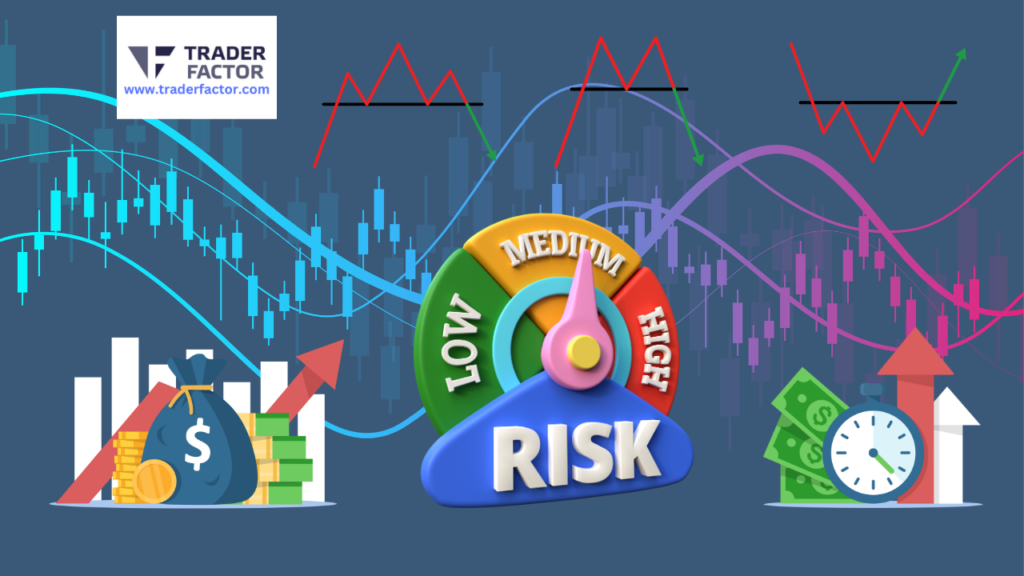Did you know that over 90% of forex traders lose money? To avoid becoming part of this statistic, it’s crucial to have effective risk management strategies in place. In this guide, we will explore the top 10 strategies for successful forex risk management.
By following these strategies, you can minimize potential losses and maximize your chances of success in the forex market. From setting clear risk management goals to utilizing hedging strategies, we will cover all the essential techniques that every forex trader should know.
So, whether you’re a beginner or an experienced trader, read on to discover how to navigate the forex market with confidence and protect your capital.
Key Takeaways
- Establish risk management targets and objectives
- Assess and regularly reassess risk tolerance
- Determine appropriate position sizing and use stop-loss orders
- Diversify investments and maintain a balanced portfolio
Set Clear Risk Management Goals

To effectively manage your forex risk, it’s crucial to establish clear risk management goals. By setting risk management targets and establishing risk management objectives, you can effectively navigate the volatile forex market and protect your investments.
When setting your risk management targets, it’s important to consider your risk tolerance and financial goals. Determine how much of your capital you’re willing to risk on each trade and set a maximum loss limit. This will help you avoid making impulsive decisions and prevent significant losses.
Additionally, establishing risk management objectives will ensure that you have a clear plan in place for managing your forex risk. Define your desired risk-reward ratio, which represents the potential profit you’re willing to make about the amount of risk you’re taking. This will help you determine the appropriate position size for each trade and avoid overexposure.
Furthermore, consider implementing stop-loss orders and take-profit orders to automatically limit your losses and secure your profits. These orders will help you maintain discipline and protect your investments in the event of unexpected market movements.
Determine Your Risk Tolerance

Assess your comfort level with risk to determine how much you’re willing to tolerate in your forex trading. Understanding your risk tolerance is crucial in developing effective risk management techniques. It involves evaluating your ability to handle potential losses and the impact they may have on your overall financial situation. The risk assessment process helps you identify your risk appetite and set appropriate risk limits.
To determine your risk tolerance, consider factors such as your financial goals, investment experience, and emotional resilience. Ask yourself how much you’re willing to lose and how it would affect your financial well-being. Are you comfortable with short-term fluctuations in your trading account? Or do you prefer a more conservative approach with limited risk exposure?
By understanding your risk tolerance, you can tailor your risk management strategies accordingly. For example, if you have a low-risk tolerance, you may opt for tighter stop-loss orders or smaller position sizes. On the other hand, if you have a higher risk tolerance, you may be more willing to take on larger positions and wider stop-loss levels.
Remember that risk tolerance is subjective and may change over time. Regularly reassess your risk tolerance as you gain more experience and adapt to market conditions. It’s essential to find a balance between risk and reward that aligns with your circumstances and trading objectives.
Use Proper Position Sizing Techniques

When determining your risk tolerance, it’s important to use proper position sizing techniques for successful forex risk management. Proper risk and position management are crucial in ensuring that you protect your trading capital and maximize your potential profits.
Position sizing refers to the process of determining the appropriate amount of capital to allocate to each trade based on your risk tolerance and the size of your trading account. By using proper position sizing techniques, you can effectively manage your risk and avoid potential losses that could wipe out your account.
One commonly used position sizing technique is the fixed percentage method. This involves risking a fixed percentage of your trading capital on each trade, usually ranging from 1% to 3%. This technique ensures that you aren’t putting too much of your capital at risk on any single trade, allowing you to maintain a diversified portfolio and withstand potential losses.
Another position sizing technique is the volatility-based method. This involves adjusting your position size based on the volatility of the currency pair you’re trading. By reducing your position size in highly volatile markets and increasing it in less volatile markets, you can better manage your risk and adapt to changing market conditions.
Implement Stop Loss Orders

To successfully implement stop-loss orders in your forex trading, it’s important to understand their significance.
Setting stop loss levels allows you to limit potential losses and protect your capital.
Importance of Stop Loss
Implementing stop-loss orders is crucial for effectively managing risk in Forex trading. The importance of risk management can’t be emphasized enough, as it plays a significant role in determining your success as a trader.
By implementing stop-loss orders, you’re taking proactive steps to protect your capital and mitigate potential losses. A stop loss order is a predetermined level at which your trade will automatically close, limiting your losses. This tool allows you to set a maximum loss that you’re willing to endure, ensuring that you don’t lose more than you can afford.
Setting Stop Loss
To effectively manage your risk in Forex trading, you need to set stop-loss orders. Setting a stop loss is a crucial step in achieving your risk management goals. By setting a stop loss order, you determine the maximum amount of loss you’re willing to tolerate on a trade.
This helps protect your capital and prevents you from experiencing significant losses. When setting a stop loss, it’s important to consider factors such as market volatility, support and resistance levels, and your risk appetite.
It’s recommended to set your stop loss at a level where it’s unlikely to be triggered by normal market fluctuations but still provides a reasonable level of protection.
Remember, the purpose of setting a stop loss is to limit your losses and preserve your trading capital, so it’s essential to be disciplined and adhere to your predetermined stop loss levels.

Benefits of Stop Loss
You can experience several benefits by implementing stop-loss orders in your Forex trading strategy. One of the main advantages is the protection it provides against potential losses. By setting a stop loss level, you can limit the amount of money you are willing to lose on a trade. This helps you manage your risk effectively and prevents emotional decision-making.
Additionally, stop-loss orders can also help you lock in profits. For example, if the market moves in your favor, you can adjust your stop loss level to a higher price, ensuring that you secure a portion of your profits.
Another benefit is the use of trailing stops, which allow you to protect your profits as the market moves in your favor. By automatically adjusting the stop loss level as the price increases, trailing stops allow you to capture more gains while still protecting against potential losses.
Overall, implementing stop-loss orders is essential for successful Forex trading as it emphasizes the importance of risk management and helps maximize your potential profits.
| Benefits of Stop Loss | ||
|---|---|---|
| Protection against potential losses | Lock in profits | Use of trailing stops |
Diversify Your Portfolio

One effective way to manage risk in forex trading is by diversifying your portfolio across different currency pairs. Diversification benefits your risk management strategies by spreading out your investments and reducing the impact of any single currency pair on your overall portfolio.
By trading multiple currency pairs, you aren’t solely reliant on the performance of one pair. Different currency pairs have unique characteristics and are influenced by different factors, such as economic indicators, geopolitical events, and central bank policies.
Diversifying your portfolio allows you to take advantage of opportunities in various markets and reduces the risk of being overly exposed to a specific currency pair.

Moreover, diversification helps to protect your portfolio in case of unexpected market movements or volatility. If one currency pair experiences a significant price drop, your losses can be offset by gains in other pairs. This can help mitigate the impact of potential losses and stabilize your overall trading performance.
In addition, diversifying your portfolio can also help improve your trading skills and knowledge. As you trade different currency pairs, you gain a better understanding of their unique characteristics, price patterns, and market dynamics. This knowledge can be valuable in making informed trading decisions and developing effective strategies.
Stay Informed With Market Analysis

By diversifying your portfolio across different currency pairs, you can effectively manage risk in forex trading and stay informed with market analysis.
One of the key aspects of staying informed is conducting thorough market research. This involves analyzing various factors that can influence currency movements, such as economic indicators.
Economic indicators provide valuable insights into the health of an economy and can help you make informed trading decisions. Key economic indicators include GDP growth, inflation rates, interest rates, and employment data.
By keeping an eye on these indicators, you can anticipate potential market movements and adjust your trading strategy accordingly.

Additionally, staying informed with market analysis involves keeping up with the latest news and developments that can impact the forex market. This includes monitoring geopolitical events, central bank announcements, and any other factors that may affect currency values. By staying informed, you can identify trading opportunities and better manage your risk exposure.
Regularly conducting market research and staying informed with economic indicators and market analysis will give you a competitive edge in forex trading.
Monitor and Adjust Your Risk Exposure

To effectively monitor and adjust your risk exposure in Forex trading, you need to regularly assess the level of risk in your portfolio.
This involves staying informed about market conditions and adapting your strategies accordingly.
Regular Risk Assessment
Monitoring and adjusting your risk exposure is crucial for successful forex risk management. Regular risk assessment allows you to identify and reduce trading risks to protect your capital and maximize your profits.
By regularly evaluating your risk exposure, you can make informed decisions about adjusting your trading strategies and positions. This helps you to stay ahead of potential risks and adapt to changing market conditions.

To conduct a regular risk assessment, you can use the following table:
| Risk Factor | Assessment |
|---|---|
| Market volatility | Measure market trends and fluctuations to gauge potential risks. |
| Economic indicators | Stay updated on economic data and news to assess their impact on your trades. |
| Position sizing | Evaluate the size of your positions to ensure they align with your risk tolerance. |
Regular risk assessment empowers you to proactively manage your risk exposure and make necessary adjustments to protect your investments. By continuously monitoring and adapting to market conditions, you can optimize your trading strategy and increase your chances of success in the forex market.
Adapt to Market Conditions
Regularly monitoring and adjusting your risk exposure is essential for adapting to market conditions and successfully managing your forex risk.
Market analysis plays a crucial role in helping you understand the current market conditions and make informed decisions about your risk exposure. By regularly conducting market analysis, you can identify trends, patterns, and potential risks that may impact your trades.

This allows you to adjust your risk exposure accordingly, either by reducing it during times of increased volatility or increasing it when market conditions are favorable.
Additionally, continuous risk assessment is necessary to ensure that your risk exposure aligns with your risk tolerance and trading goals.
Utilize Risk-Reward Ratios

You can maximize your forex trading success by effectively utilizing risk-reward ratios. Risk-reward analysis is a crucial component of successful trading, as it helps you determine the potential profitability of a trade relative to the risk involved.
By using risk-reward ratios, you can make informed decisions about where to enter and exit trades, ensuring that your potential rewards outweigh the potential risks.
To better understand how risk-reward ratios work, take a look at the table below:
| Trade | Entry Price | Stop Loss | Target Price | Risk-Reward Ratio |
|---|---|---|---|---|
| 1 | 1.2000 | 1.1900 | 1.2200 | 1:2 |
| 2 | 1.3500 | 1.3400 | 1.3800 | 1:3 |
| 3 | 0.9800 | 0.9700 | 1.0200 | 1:2 |
In trade 1, the potential reward is twice the risk, meaning that if you win this trade, you will make twice as much as you risk. In trade 2, the potential reward is three times the risk, offering an even higher potential profit. Trade 3 also has a risk-reward ratio of 1:2.
Take Advantage of Hedging Strategies

To effectively manage forex risk, you can take advantage of hedging strategies. By utilizing hedging techniques, you can reduce the potential losses from adverse market movements.
This involves diversifying your investment portfolio and protecting against market fluctuations, ensuring a more balanced and secure approach to forex trading.
Reducing Trading Risks
By implementing hedging strategies, you can effectively reduce the risks associated with your trades in the forex market. One way to reduce trading risks is by reducing leverage.
Leverage allows you to control larger positions with a smaller amount of capital, but it also increases the potential for losses. By lowering your leverage, you can limit the amount of risk you’re exposed to.
Another important aspect of reducing trading risks is managing your risk management psychology. Emotions such as fear and greed can cloud your judgment and lead to poor decision-making. It’s essential to maintain a disciplined mindset and stick to your trading plan to avoid impulsive actions that can increase your risks.

Diversifying Investment Portfolio
To further mitigate trading risks, consider diversifying your investment portfolio and take advantage of hedging strategies. Diversification involves spreading your investments across different asset classes and sectors to reduce the impact of any single investment on your overall portfolio.
By doing so, you can potentially decrease your exposure to volatility and increase the potential for returns. Additionally, incorporating hedging strategies can help protect your portfolio from adverse market movements. This involves using instruments such as options or futures contracts to offset potential losses in one investment with gains in another.
Rebalancing investments and adjusting asset allocation periodically can also help maintain the desired risk-return profile of your portfolio. Consider the following table for a visual representation of diversification and hedging strategies:
| Diversification Strategies | Hedging Strategies | Rebalancing Investments |
|---|---|---|
| Spreading investments across different asset classes and sectors | Using options or futures contracts to offset potential losses | Adjusting asset allocation periodically |
| Reducing the impact of any single investment on your portfolio | Protecting your portfolio from adverse market movements | Maintaining desired risk-return profile |
| Decreasing exposure to volatility | Offset potential losses with gains in another investment | Ensuring investments align with changing market conditions |
| Increasing potential for returns | Managing downside risk | Reallocating capital to optimize returns |
| Lowering overall portfolio risk | Minimizing potential losses | Adapting to changing investment opportunities |
Protect Against Market Fluctuations
Diversify your investment portfolio and protect against market fluctuations by taking advantage of hedging strategies.
Hedging is one of the most effective protective strategies for managing risk in the forex market. It involves opening two or more positions that offset each other’s potential losses. By doing so, you can mitigate the impact of market fluctuations and minimize your risk exposure.

Hedging techniques include using options contracts, futures contracts, or even trading correlated currency pairs. These risk management techniques allow you to protect your investments and limit potential losses.
Maintain Discipline and Emotional Control

Stay focused and stick to your trading plan to effectively manage risk in the forex market. Maintaining discipline and controlling your emotions is essential for successful forex risk management.
It’s common for traders to let their emotions dictate their decisions, leading to impulsive actions and poor risk management. However, by staying disciplined and emotionally controlled, you can make rational decisions based on your trading plan and risk tolerance.
One way to maintain discipline is to set clear trading goals and follow a predetermined strategy. Stick to your plan and avoid making impulsive trades based on emotions or short-term market fluctuations. It’s important to have a set of rules that you strictly adhere to, such as setting stop-loss and take-profit levels and sticking to them regardless of market conditions.

Controlling your emotions is equally important. Fear and greed are two powerful emotions that can cloud your judgment and lead to poor decision-making. To overcome these emotions, it’s crucial to stay calm and rationalize your actions. Take time to analyze the market before making any trading decisions and always consider the potential risks involved.
Frequently Asked Questions
Strategies for Successful Forex Risk Management

How Do I Set Clear Risk Management Goals in Forex Trading?
Set clear risk management goals in forex trading by first setting realistic expectations and understanding the importance of diversification. This will help you minimize losses and maximize profits, ultimately leading to successful trading.
What Factors Should I Consider When Determining My Risk Tolerance in Forex Trading?
When determining your risk tolerance in forex trading, consider factors such as your financial goals and trading experience. These elements will help guide you in making informed decisions about the level of risk you are comfortable taking.
What Are Proper Position Sizing Techniques and How Do I Use Them Effectively in Forex Trading?
To effectively manage your risk in forex trading, it is crucial to employ proper position sizing techniques. This involves determining the appropriate amount of capital to allocate to each trade based on your risk tolerance and overall trading strategy.
What Is a Stop Loss Order and How Can I Implement It to Manage Risk in Forex Trading?
To manage risk in forex trading, you need to understand the importance of stop-loss implementation. A stop-loss order allows you to set a predetermined exit point for a trade, limiting potential losses.
What Are Some Effective Hedging Strategies That I Can Use in Forex Trading to Mitigate Risk?
To mitigate risk in forex trading, you can use effective hedging strategies. These strategies help protect your investments by offsetting potential losses with corresponding gains, ensuring a balanced risk management approach.

Conclusion
In conclusion, by following these top 10 strategies for successful forex risk management, you can greatly increase your chances of success in the forex market.
Setting clear goals, determining your risk tolerance, using proper position sizing techniques, and implementing stop loss orders are all essential steps to effectively manage your risk.
Diversifying your portfolio, monitoring and adjusting your risk exposure, and utilizing risk-reward ratios can help you spread out your investments and make informed decisions.
Taking advantage of hedging strategies can further protect your investments and minimize potential losses.
Finally, maintaining discipline and emotional control is crucial in staying focused and making rational decisions.
By implementing these strategies, you can effectively manage your risk and maximize your profits in the forex market.
Disclaimer:
All information has been prepared by TraderFactor or partners. The information does not contain a record of TraderFactor or partner’s prices or an offer of or solicitation for a transaction in any financial instrument. No representation or warranty is given as to the accuracy or completeness of this information. Any material provided does not have regard to the specific investment objective and financial situation of any person who may read it. Past performance is not a reliable indicator of future performance.
FOLLOW US




No comments:
Post a Comment